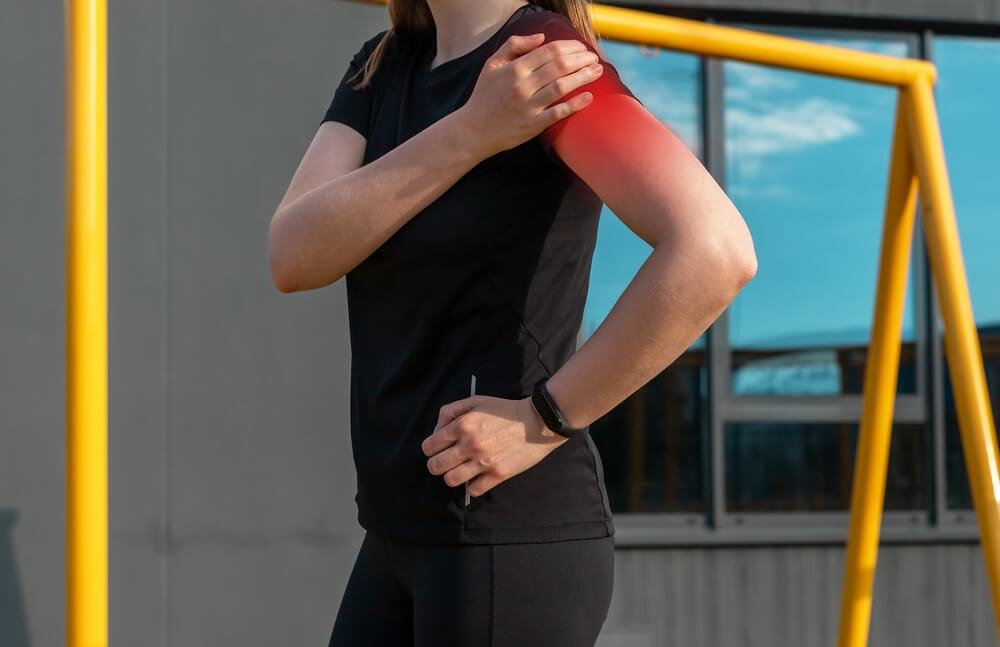Top 7 Rotator Cuff Exercises for Pain Relief and Strength
1. Pendulum Swing
The pendulum swing is one of the best rotator cuff exercises for pain relief in the early stages of recovery. To perform, lean forward slightly and support yourself with one hand on a table. Let your injured arm hang down freely. Gently move it in small circles, both clockwise and anti-clockwise, for 30–60 seconds. This simple movement helps improve blood flow, reduces stiffness, and relieves shoulder pain without putting too much strain on the joint. Many physiotherapists in Norwest recommend pendulum swings as a safe first step in rotator cuff physiotherapy programs.
2. External Rotation with Band
External rotation using a resistance band is an effective rotator cuff strengthening exercise. Attach the band to a doorknob or stable object. Stand sideways, keeping your elbow bent at 90 degrees and close to your body. Hold the band and slowly pull your hand outward, away from your body. Return gently to the starting position. This exercise strengthens the infraspinatus and teres minor muscles, which are crucial for shoulder stability. Performing this movement 10–15 times, three sets per side, can help relieve shoulder pain and support physiotherapy for rotator cuff injuries in Norwest.
3. Internal Rotation with Band
The internal rotation exercise works the opposite muscles of the rotator cuff and is vital for balanced shoulder strength. Using the same resistance band setup, stand with your elbow bent at 90 degrees and tucked close to your body. Pull the band inward across your stomach and slowly return. This is one of the most common shoulder rehab exercises recommended by physiotherapists for pain relief and recovery. By strengthening internal rotator muscles, you reduce the risk of shoulder instability and discomfort. Patients visiting Norwest Central Physiotherapy & Sports Clinic often start with this simple but effective exercise.
4. Scaption (Shoulder Raise)
Scaption, or the shoulder raise, is one of the best exercises for rotator cuff pain relief and strength. Stand upright with arms at your sides and thumbs pointing upward. Slowly raise your arms in a “V” shape at about 30 degrees from your body until they reach shoulder level. Lower them gently. This move strengthens the supraspinatus muscle, which often gets injured in rotator cuff problems. Regular scaption practice improves mobility, reduces stiffness, and supports recovery from shoulder pain physiotherapy in Norwest. Start with light weights or no weights until your shoulder feels stronger.
5. Wall Angels
Wall angels are excellent for improving posture and building shoulder strength. Stand with your back flat against a wall, feet slightly away, and arms in a goalpost position. Slowly raise your arms upward, keeping them close to the wall, then return to the starting point. This exercise not only engages the rotator cuff muscles but also improves flexibility and reduces shoulder tightness. Many patients doing rotator cuff physiotherapy in Norwest find wall angels helpful for restoring pain-free movement. Performing 2–3 sets of 10 repetitions regularly can ease discomfort and enhance your shoulder’s overall function.
6. Sleeper Stretch
The sleeper stretch is one of the most effective rotator cuff exercises for shoulder pain relief. Lie on your side with the painful shoulder on the bottom. Bend your elbow to 90 degrees with your forearm pointing upward. Use your top hand to gently press your lower arm toward the floor. Hold for 20–30 seconds, then relax. This stretch targets the posterior capsule and rotator cuff muscles, reducing stiffness and improving mobility. If you’re undergoing physiotherapy for shoulder pain in Norwest, your physiotherapist may include this stretch to improve flexibility and reduce discomfort during recovery.
7. Shoulder Blade Squeeze
Shoulder blade squeezes are simple yet powerful rotator cuff strengthening exercises. Sit or stand with your back straight. Pull your shoulder blades back and down, as if trying to pinch them together. Hold for 5 seconds and relax. Repeat 10–15 times. This exercise strengthens the muscles that stabilise the shoulder, which is essential for preventing rotator cuff injuries. It also helps improve posture, making it a key part of shoulder physiotherapy programs in Norwest. Incorporating this exercise daily can reduce shoulder pain, improve alignment, and support overall rotator cuff health for long-term relief.

